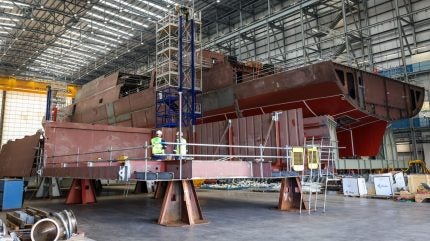
UK defence prime Babcock has recognised a £90m ($117.2m) loss for the Type 31 frigate programme, intended to deliver five multipurpose warships to the UK Royal Navy, according to the company’s FY2024 results, citing design changes and increased labour costs.
Detailing a FY2024 results update on 17 July, Babcock stated that underlying operating profit rose 34% to £238m, but that this included a £90m loss on the Type 31 frigate programme.
The UK shipbuilding and defence prime said the Type 31 loss was “fully recognised” in FY24, with the cash impact of the loss to be recognised over the life of the contract.
“Overall estimated programme costs have increased due to the maturing of the design and increase in the forecast cost of labour,” Babcock stated in its FY24 results.
Babcock has previously voiced its concern about the profitability of the Type 31 programme, which was planned to deliver five frigates to the Royal Navy at an average cost of £250m per vessel, for a programme total of £1.25bn.
The design originally planned to use a significant quantity of government furnished equipment (GFE) in the build process, with systems taken from five general purpose Type 23 frigates they will replace.
However, the Type 31 uses a different combat management system, radar, and main and secondary guns to the in-service Type 23 frigates, while it is also planned to integrate the Mk41 vertical launch system (VLS) that can incorporate surface-to-air missiles, and other munitions.
The Type 31 was designed to fit the Sea Ceptor “mushroom farm” to fulfill its air defence capability, although the addition of the Mk 41 VLS could see this plan axed.
It is possible that the five Type 31 frigates will be completed in two distinct batches, with earlier vessels fitted-for-but-not-with the Mk41, while later vessels see the VLS integration during construction.
Profitability concerns over Type 31 frigates
Due to forecast losses, Babcock started a dispute resolution process with the UK Ministry of Defence (MoD) in April 2023, although this was paused in November the same year “following customer discussions”, it was stated at the time, with up to £100m in additional funding thought needed.
Earlier, providing a 2023 financial year and Type 31 update on 20 April 2023, Babcock said it recognised over £600m in revenue on the programme, which remained on schedule and due to conclude in 2028.
However, the programme’s production plan was described as “demanding”, given the impact felt by UK industry during the Covid-19 pandemic, and had seen an increase in actual and projected costs.
Babcock said at the time that despite having been in dialogue with the MoD as to who is responsible for the additional costs under the contact, it had been “unable to reach agreement” and, as such, saw a DRP commence.
“Without recovery of the additional costs, the contract would be loss-making and our preliminary assessment, subject to finalisation and audit, is that a one-off provision of between £50 million and £100 million would be required to cover the duration of the contract,” Babcock stated in April 2023.
Build of HMS Active continues
Meanwhile, the second of five Type 31 frigates, the future HMS Active, being built for the UK Royal Navy saw a significant step in its manufacture recently, with two major blocks lifted and turned to prepare for integration at Babcock’s Venturer Building in Rosyth.
In a 16 July social media post, Babcock stated that sections Double Bottom 03 and Hull Block 05 were lifted by the Goliath crane at its Rosyth shipyard, ahead of being moved into the build hall later in July. The two lifts were carried out over a period of six days, the company said.
According to the UK’s shipbuilding programme, five Type 31 Inspiration-class general-purpose frigates will be introduced into Royal Navy service from 2027, with Babcock completing the handover of the fifth and final vessel the following year.







